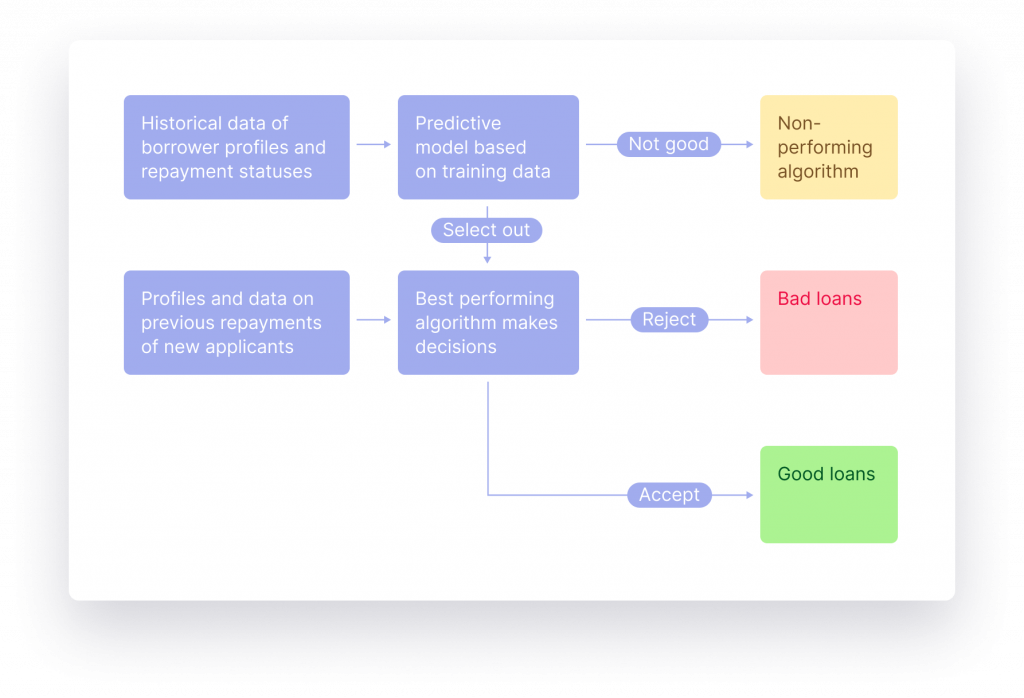
Credit, when done right, is a sign of a healthy economy. Over 117 of the world’s 191 recognized economies have some form of a credit-giving body in one form or another. The World Bank even highlight’s its existence as having a positive impact on growth—if done correctly.
With the advent of newer and more effective technologies, this finding the creditworthy—healthy credit—has become both easier—it’s quickly to manage the data and information to deliver results—and more complicated—it’s a challenge to find the right technology partner. One way to do so with credit scoring via a machine learning model that helps uncover risk and manage it effectively. Machine learning for credit scoring can help to:
- Analyze a vast range of data to offer more accurate predictions.
- Detect patterns and reduce occurrences of fraud.
- Coordinate the document process including onboarding and data gathering.
- Manage investment portfolio in an even more in-depth way.
Best practices: credit scoring using machine learning
Although each of machine learning credit scoring benefits are valuable, many companies find themselves stumbling when it comes to their implementation. Let’s take a look at some of the best ways they can work for a number of businesses.
Tracking data
Data training is part and parcel of credit scoring systems. However, errors can arise if such systems are not properly trained or checked. With credit scoring with machine learning, models learn from each incoming set of data and other data sets to ‘train’ and become better.
These systems intake historical data, such as past loan applications, including information on the borrower’s credit history, income, and other relevant factors to identify patterns or risks in a borrower’s life and that may indicate their ability and intention to pay back a loan.
With a vast range of accurate and clean data sets machine learning credit scoring can be an effective tool in spotting risk even earlier.
Evaluating credit scoring models
Evaluating models is a vital step to ensuring that particular model is effective at predicting risk. This reduces errors and avoid misclassifying potential application who are credit-worthy.
By using machine learning credit scoring techniques, such as model evaluation, your business will be able to test the model’s performance before it goes live. This will evaluate the performance of a credit scoring model include accuracy, precision, recall, and the area under the Receiver Operating Characteristic (ROC) curve to give a precise result.
These tools can also be used to compare past results to alternative models to determine, which is more effective at predicting risk in these circumstances.

Determining threshold-based investments
How do you know where the cut-off point is? For many, it may be a theoretical number. But it should be this way. Modern credit scoring using machine learning allow businesses to assess the risk beforehand and determine the risk of default based on numerous factors.
Not only does this establish whether or not this person should be approved or denied a loan, it can also determine the level of risk that an organization is taking on by approval a certain application—leaving final decision-making to the human agent.
By determining the optimal cut-off point for loan performance, companies can not only lower their risk, but increase their profits due to the ability to take on more seemingly ‘risky’ clients, that have unusual backgrounds, and increasing the creditable number of people in the community.
Analyzing the risk vs. return ratio
The financial world is all about risk and return. This is how profitability is calculated. Machine learning for credit scoring models are the perfect tool for the job. By training ML tools on historical data and the likelihood of return history, past loan behavior can be used to inform future models.
By implementing such tools in the process, companies can manage a variety of loan-related risks, including risks associated with investments, such as credit risk, market risk, and liquidity risk. It can also be used to establish patterns in a consumer’s return behavior or non-payment behavior to establish future lending conditions more effectively.
This allows companies to optimize their risk levels, improve their lending standards and increase their profitability.
Benefits of machine learning in credit scoring
Now that you know the top features and uses that machine learning in credit scoring can be used for, let’s take a look at why you should consider onboarding this technology now, more so than ever before:
- Automation improves efficiency—machine learning credit scoring algorithms efficiently perform tasks and consistently do so, to ensure a steady flow of applications. This allows staff to concentrate on more nuanced applications and other tasks.
- Improved accuracy prevents additional risk—trained ML models can tackle huger and more diverse datasets than any human. This is what makes them so powerful and delivers the opportunity to predict creditworthiness more accurately.
- Reduces bias and influence—although ML models are trained by humans, technology can be employed to reduce bias and ensure a more successful and fair credit process for all involved.
- Overall efficiency increased—from upgrading current data management systems to ensuring information gets on the right person’s desk, ML can help. It allows staff members to access information and approve or deny leans even faster.
- Better customer experiences—collecting user feedback to learning from those out-of-town, ML tools free up spare time to allow people to take advantage of the flexibility and ensure they are treated as the important clients they are.
Adopting machine learning for credit scoring system
Deciding to onboard a new technology is a massive step in any business. Although the benefits of machine learning credit scoring systems are quite tempting, it’s important to remember that onboarding a new tech solution without a strategy is a recipe for disaster. Instead, plan out your investment and find a way to make it suit your business, not the other way around.
If you’re looking to boost your tech stack and avoid the rest, get in touch with the people who know best — GiniMachine. Our team will talk you through the ins and outs of our solution to find the right one that works best for you and your company.



